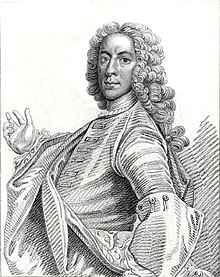John Taylor (oculist)
John Taylor (* 1703 in Norwich , † November 16, 1770 in Rome ) was an English oculist and medical charlatan .
Life
Taylor learned the surgical trade in London from the British surgeon William Cheselden at St Thomas' Hospital .
In the course of his activity he operated on celebrities of the time such as Edward Gibbon , met the composer Gottfried van Swieten and became the court oculist of King George II. He described himself as a " Chevalier ".
He later traveled to Europe in a carriage that was painted with pictures of eyes, and practiced star stitch and other eye operations, although he was careful to leave the respective city as soon as possible after his carnival-like appearances and receipt of payment. In his 1761 autobiography, Taylor referred to himself as " Ophthalmiater (sic) Pontifical, Imperial, Royal ".
According to independent reports, Taylor harmed his patients. At the end of March 1750 he operated on Johann Sebastian Bach's cataract in Leipzig , whereupon Bach went blind and died a quarter of a year later. In August 1758, Taylor Georg Friedrich Handel operated on in Tunbridge Wells , and Handel's health deteriorated noticeably afterwards. In both cases, however, Taylor boasted complete success. The Dutch ophthalmologist R. Zegers notes: "After his training, Taylor began to practice in Switzerland, where he made hundreds of patients blind, as he once confessed."
Before each operation, Taylor gave a long, self-praising speech, which he delivered in a very special rhetorical style. Contemporary Samuel Johnson said of Taylor that Taylor's life "is an example of how far presumptuousness can take ignorance."
Taylor died in oblivion and is said to have spent his last years in complete blindness.
Works
- An Account of the Mechanism of the Eye. 1727
- The Life and Extraordinary History of the Chevalier John Taylor. 1761 (autobiography)
literature
- Grete de Francesco : The Power of the Charlatan. Benno Schwabe, Basel 1937, pp. 185ff.
Web links
References and comments
- ↑ Charles Burney writes that Taylor died in Rome on the morning of November 16, 1770, after having had dinner with Burney at his house a few days earlier. Charles Burney: Music, Men, and Manners in France and Italy . The Folio Society, London 1969, pp. 206 .
- ^ A b David M. Jackson: Bach, Handel, and the Chevalier Taylor . In: Medical History . tape 4 , October 1968, p. 385–393 (English, musebaroque.fr [PDF; accessed November 10, 2017]).
- ^ Julius Hirschberg : History of ophthalmology . In: Th. Saemisch (ed.): Handbook of the entire ophthalmology . tape 13 . Wilhelm Engelmann, Leipzig 1899.
- ^ Christoph Wolff : Johann Sebastian Bach . 2nd Edition. S. Fischer, Frankfurt am Main 2000, ISBN 3-10-092584-X , p. 489 .
- ↑ “ after his training, Taylor started practicing in Switzerland, where he blinded hundreds of patients, he once confessed. ”R. Zegers, in: Arch Ophthalmol. 123 (2005) 1427-1430
- ^ John Barrell: London Review of Books. 2004.
- ↑ “ an instance of how far impudence may carry ignorance. ”
- ^ John Taylor: Records of My Life: In Two Volumes . tape 1 . Bull, 1832, p. 24 ( limited preview in Google Book search).
| personal data | |
|---|---|
| SURNAME | Taylor, John |
| BRIEF DESCRIPTION | English oculist and medical charlatan |
| DATE OF BIRTH | 1703 |
| PLACE OF BIRTH | Norwich |
| DATE OF DEATH | November 16, 1770 |
| Place of death | Rome |
